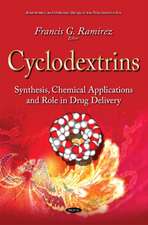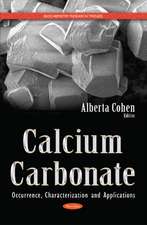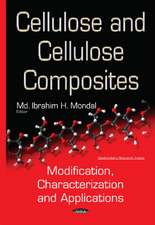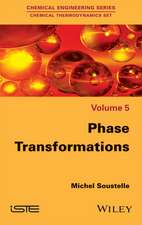Functioning of Transmembrane Receptors in Signaling Mechanisms: Cell Signaling Collection
Editat de Ralph A. Bradshaw, Edward A. Dennisen Limba Engleză Paperback – 5 apr 2011
- Articles written and edited by experts in the field
- Thematic volume covering effectors, cytosolic events, nuclear, and cytoplasmic events
- Up-to-date research on signaling systems and mutations in transcription factors that provide new targets for treating disease
Preț: 365.32 lei
Preț vechi: 458.42 lei
-20% Nou
Puncte Express: 548
Preț estimativ în valută:
69.90€ • 72.12$ • 58.34£
69.90€ • 72.12$ • 58.34£
Carte tipărită la comandă
Livrare economică 19 martie-02 aprilie
Preluare comenzi: 021 569.72.76
Specificații
ISBN-13: 9780123822116
ISBN-10: 0123822114
Pagini: 456
Ilustrații: illustrations
Dimensiuni: 216 x 276 x 25 mm
Greutate: 1.34 kg
Editura: ELSEVIER SCIENCE
ISBN-10: 0123822114
Pagini: 456
Ilustrații: illustrations
Dimensiuni: 216 x 276 x 25 mm
Greutate: 1.34 kg
Editura: ELSEVIER SCIENCE
Public țintă
Professionals, researchers and graduate students in molecular biology, biochemistry, cell biology, biomedicine, structural biology, systems biology, and genetics.Cuprins
1. Cell Signaling: Yesterday, Today, and Tomorrow
2. Structural and Energetic Basis of Molecular Recognition
3. Free Energy Landscapes in Protein-Protein Interactions
4. Molecular Sociology
5. Antibody–Antigen Recognition and Conformational Changes
6. Binding Energetics in Antigen–Antibody Interfaces
7. Immunoglobulin–Fc Receptor Interactions
8. Ig-Superfold and its Variable Uses in Molecular Recognition
9. T Cell Receptor/pMHC Complexes
10. Mechanistic Features of Cell Surface Adhesion Receptors
11. The Immunological Synapse
12. NK Receptors
13. Carbohydrate Recognition and Signaling
14. Rhinovirus–Receptor Interactions
15. HIV-1 Receptor Interactions
16. Influenza Virus Neuraminidase Inhibitors
17. Structural Basis of Signaling Events Involving Fibrinogen and Fibrin
18. Structural Basis of Integrin Signaling
19. Structures of Heterotrimeric G Proteins and their Complexes
20. G-Protein-Coupled Receptor Structures
21. Toll-like Receptors – Structure and Signaling
22. Variable Lymphocyte Receptors
23. Structure and Function of G-Protein-Coupled Receptors: Lessons from Recent Crystal Structures
24. Chemokines and Chemokine Receptors: Structure and Function
25. The 2 Adrenergic Receptor as a Model for G-Protein-Coupled Receptor Structure and Activation
26. Protease-Activated Receptors
27. Agonist-Induced Desensitization and Endocytosis of G-Protein-Coupled Receptors
28. Functional Role(s) of Dimeric Complexes Formed from G-Protein-Coupled Receptors
29. Chemotaxis Receptors in Bacteria: Transmembrane Signaling, Sensitivity, Adaptation, and Clustering
30. An Overview of Ion Channel Structure
31. Molecular Mechanism of Store-Operated Ca2+ Signaling and CRAC Channel Activation Mediated
32. Ion Permeation: Mechanisms of Ion Selectivity and Block
33. Nicotinic Acetylcholine Receptors
34. Ion Channels Regulated by Direct Binding of Cyclic Nucleotides
35. Overview of Cytokine Receptors
36. Growth Hormone and Prolactin Family of Hormones and Receptors: The Structural Basis for Receptor Activation and Regulation
37. Erythropoietin Receptor as a Paradigm for Cytokine Signaling
38. The Fibroblast Growth Factor (FGF) Signaling Complex
39. Structure of IFN-g and its Receptors
40. Structure and Function of Tumor Necrosis Factor (TNF) at the Cell Surface
41. The Mechanism of NGF Signaling Suggested by the p75 and TrkA Receptor Complexes
42. The Mechanism of VEGFR Activation by VEGF
43 . Receptor–Ligand Recognition in the TGFb Superfamily as Suggested by Crystal Structures
44. Insulin Receptor Complex and Signaling by Insulin
45. Structure and Mechanism of the Insulin Receptor Tyrosine Kinase
46. IL-21 Increased Potency Desig
47. Signaling of IL-4R, a Typical Class I Cytokine Receptor: What Defines the Quiescent State?
48. Epidermal Growth Factor Kinases and their Activation in Receptor Mediated Signaling
49. Tumor Necrosis Factor Receptor-Associated Factors in Immune Receptor Signal Transduction
50. Assembly of Signaling Complexes for TNF Receptor Family Molecules
51. Mechanisms of CD40 Signaling in the Immune System
52. Role of Lipid Domains in EGF Receptor Signaling
53. Lipid-Mediated Localization of Signaling Proteins
54. Organization of Photoreceptor Signaling Complexes
55. Transmembrane Receptor Oligomerization
2. Structural and Energetic Basis of Molecular Recognition
3. Free Energy Landscapes in Protein-Protein Interactions
4. Molecular Sociology
5. Antibody–Antigen Recognition and Conformational Changes
6. Binding Energetics in Antigen–Antibody Interfaces
7. Immunoglobulin–Fc Receptor Interactions
8. Ig-Superfold and its Variable Uses in Molecular Recognition
9. T Cell Receptor/pMHC Complexes
10. Mechanistic Features of Cell Surface Adhesion Receptors
11. The Immunological Synapse
12. NK Receptors
13. Carbohydrate Recognition and Signaling
14. Rhinovirus–Receptor Interactions
15. HIV-1 Receptor Interactions
16. Influenza Virus Neuraminidase Inhibitors
17. Structural Basis of Signaling Events Involving Fibrinogen and Fibrin
18. Structural Basis of Integrin Signaling
19. Structures of Heterotrimeric G Proteins and their Complexes
20. G-Protein-Coupled Receptor Structures
21. Toll-like Receptors – Structure and Signaling
22. Variable Lymphocyte Receptors
23. Structure and Function of G-Protein-Coupled Receptors: Lessons from Recent Crystal Structures
24. Chemokines and Chemokine Receptors: Structure and Function
25. The 2 Adrenergic Receptor as a Model for G-Protein-Coupled Receptor Structure and Activation
26. Protease-Activated Receptors
27. Agonist-Induced Desensitization and Endocytosis of G-Protein-Coupled Receptors
28. Functional Role(s) of Dimeric Complexes Formed from G-Protein-Coupled Receptors
29. Chemotaxis Receptors in Bacteria: Transmembrane Signaling, Sensitivity, Adaptation, and Clustering
30. An Overview of Ion Channel Structure
31. Molecular Mechanism of Store-Operated Ca2+ Signaling and CRAC Channel Activation Mediated
32. Ion Permeation: Mechanisms of Ion Selectivity and Block
33. Nicotinic Acetylcholine Receptors
34. Ion Channels Regulated by Direct Binding of Cyclic Nucleotides
35. Overview of Cytokine Receptors
36. Growth Hormone and Prolactin Family of Hormones and Receptors: The Structural Basis for Receptor Activation and Regulation
37. Erythropoietin Receptor as a Paradigm for Cytokine Signaling
38. The Fibroblast Growth Factor (FGF) Signaling Complex
39. Structure of IFN-g and its Receptors
40. Structure and Function of Tumor Necrosis Factor (TNF) at the Cell Surface
41. The Mechanism of NGF Signaling Suggested by the p75 and TrkA Receptor Complexes
42. The Mechanism of VEGFR Activation by VEGF
43 . Receptor–Ligand Recognition in the TGFb Superfamily as Suggested by Crystal Structures
44. Insulin Receptor Complex and Signaling by Insulin
45. Structure and Mechanism of the Insulin Receptor Tyrosine Kinase
46. IL-21 Increased Potency Desig
47. Signaling of IL-4R, a Typical Class I Cytokine Receptor: What Defines the Quiescent State?
48. Epidermal Growth Factor Kinases and their Activation in Receptor Mediated Signaling
49. Tumor Necrosis Factor Receptor-Associated Factors in Immune Receptor Signal Transduction
50. Assembly of Signaling Complexes for TNF Receptor Family Molecules
51. Mechanisms of CD40 Signaling in the Immune System
52. Role of Lipid Domains in EGF Receptor Signaling
53. Lipid-Mediated Localization of Signaling Proteins
54. Organization of Photoreceptor Signaling Complexes
55. Transmembrane Receptor Oligomerization
Recenzii
"This volume reprints 53 articles originally published in by Elsevier in 2010. The researchers describe the structure and role of cell surface receptors in signaling activities with separate sections on tyrosine kinase, cytokine, G protein-coupled, TGFB, TNF, and immunoglobin receptors. The opening chapters review the chemical principles of protein binding, FRET detection techniques, protein tyrosine phosphatases, and the formation of oligomers. Color figures are provided." --Reference and Research Book News














